Chapter 4 – Requirements Engineering
CS 425 October 15, 2013. Chapter 4 – Requirements Engineering. Ian Sommerville, Software Engineering , 9 th Edition Pearson Education, Addison-Wesley. Note: These are a modified version of Ch 4 slides available from the author’s site http://www.cs.st-andrews.ac.uk/~ifs/Books/SE9/.
Share Presentation
Embed Code
Link
Download Presentation
- requirements
- functional requirements
- requirements engineering
- system requirements
- system requirements specification
- chapter 4 requirements engineering

brooksp + Follow
Download Presentation
Chapter 4 – Requirements Engineering
An Image/Link below is provided (as is) to download presentation Download Policy: Content on the Website is provided to you AS IS for your information and personal use and may not be sold / licensed / shared on other websites without getting consent from its author. Content is provided to you AS IS for your information and personal use only. Download presentation by click this link. While downloading, if for some reason you are not able to download a presentation, the publisher may have deleted the file from their server. During download, if you can't get a presentation, the file might be deleted by the publisher.
Presentation Transcript
- CS 425 October 15, 2013 Chapter 4 – Requirements Engineering Ian Sommerville, Software Engineering, 9th Edition Pearson Education, Addison-Wesley Note: These are a modified version of Ch 4 slides available from the author’s site http://www.cs.st-andrews.ac.uk/~ifs/Books/SE9/ Chapter 4 Requirements engineering
- Topics covered • Functional and non-functional requirements • The software requirements specification document (SRS) • Requirements specification • Requirements engineering processes • Requirements elicitation and analysis • Requirements validation • Requirements management Chapter 4 Requirements engineering
- Requirements engineering • The process of establishing the services that the customer requires from a system and the constraintsunder which it operates and is developed • The requirements themselves are the descriptions of the system services and constraints that are generated during the requirements engineering process Chapter 4 Requirements engineering
- What is a requirement? • It may range from a high-level abstract statement of a service or of a system constraint to a detailed mathematical functional specification. • This is inevitable as requirements may serve a dual function: • May be the basis for a bid for a contract - therefore must be open to interpretation; • May be the basis for the contract itself - therefore must be defined in detail; Chapter 4 Requirements engineering
- Types of requirement • User requirements • Statements in natural language plus diagrams of the services the system provides and its operational constraints. Written for customers. • System requirements • A structured document setting out detailed descriptions of the system’s functions, services and operational constraints. Defines what should be implemented so may be part of a contract between client and contractor. Chapter 4 Requirements engineering
- User and system requirements Chapter 4 Requirements engineering
- Readers of different types of requirements specification Chapter 4 Requirements engineering
- Functional and non-functional requirements • Functional requirements • Statements of services the system should provide, how the system should react to particular inputs and how the system should behave in particular situations • May state what the system should not do • Non-functional requirements • Constraints on the services or functions offered by the system such as timing constraints, constraints on the development process, standards, etc. • Often apply to the system as a whole rather than individual features or services • Domain requirements • Constraints on the system from the domain of operation Chapter 4 Requirements engineering
- Functional requirements • Describe functionality or system services • Depend on the type of software, expected users and the type of system where the software is used • Functional user requirements may be high-level statements of what the system should do • Functional system requirements should describe the system services in detail Chapter 4 Requirements engineering
- Functional requirements for the MHC-PMS • A user shall be able to search the appointments lists for all clinics • The system shall generate each day, for each clinic, a list of patients who are expected to attend appointments that day • Each staff member using the system shall be uniquely identified by his or her 8-digit employee number Chapter 4 Requirements engineering
- Requirements imprecision • Problems arise when requirements are not precisely stated. • Ambiguous requirements may be interpreted in different ways by developers and users. • Consider the term ‘search’ in requirement 1 • User intention – search for a patient name across all appointments in all clinics • Developer interpretation – search for a patient name in an individual clinic. User chooses clinic then search. Chapter 4 Requirements engineering
- Requirements completeness and consistency • In principle, requirements should be both complete and consistent • Complete • They should include descriptions of all facilities required • Consistent • There should be no conflicts or contradictions in the descriptions of the system facilities • In practice, it is impossible to produce a complete and consistent requirements document Chapter 4 Requirements engineering
- Non-functional requirements • These define system properties and constraints e.g. reliability, response time, and storage requirements. Constraints are I/O device capability, system representations, etc. • Process requirements may also be specified mandating a particular IDE, programming language or development method. • Non-functional requirements may be more critical than functional requirements. If these are not met, the system may be useless. Chapter 4 Requirements engineering
- Types of nonfunctional requirement Chapter 4 Requirements engineering
- Non-functional requirements implementation • Non-functional requirements may affect the overall architecture of a system rather than the individual components • For example, to ensure that performance requirements are met, you may have to organize the system to minimize communications between components • A single non-functional requirement, such as a security requirement, may generate a number of related functional requirements that define system services that are required • It may also generate requirements that restrict existing requirements Chapter 4 Requirements engineering
- Non-functional classifications • Product requirements • Requirements which specify that the delivered product must behave in a particular way e.g. execution speed, reliability, etc. • Organizational requirements • Requirements which are a consequence of organizational policies and procedures e.g. process standards used, implementation requirements, etc. • External requirements • Requirements which arise from factors which are external to the system and its development process, e.g. interoperability requirements, legislative requirements, etc. Chapter 4 Requirements engineering
- Examples of nonfunctional requirements in the MHC-PMS Chapter 4 Requirements engineering
- Metrics for specifying non-functional requirements Chapter 4 Requirements engineering
- The software requirements document is the official statement of what is required of the system developers Can include both a definition of user requirements and a specification of the system requirements It is NOT a design document. As far as possible, it should set of WHAT the system should do rather than HOW it should do it The software requirements document Chapter 4 Requirements engineering
- Agile methods and requirements • Many agile methods argue that producing a requirements document is a waste of time as requirements change so quickly • The document is therefore always out of date • Methods such as XP use incremental requirements engineering and express requirements as ‘user stories’ (discussed in Chapter 3) • This is practical for business systems but problematic for systems that require a lot of pre-delivery analysis (e.g. critical systems) or systems developed by several teams Chapter 4 Requirements engineering
- Users of a requirements document Chapter 4 Requirements engineering
- The structure of a requirements document Chapter 4 Requirements engineering
- The structure of a requirements document Chapter 4 Requirements engineering
- Requirements specification • The process of writing down the user and system requirements in a requirements document • User requirements have to be understandable by end-users and customers who do not have a technical background • System requirements are more detailed requirements and may include more technical information • The requirements may be part of a contract for the system development • It is therefore important that these are as complete as possible Chapter 4 Requirements engineering
- Ways of writing a system requirements specification Chapter 4 Requirements engineering
- In principle, requirements should state what the system should do and the design should describe how it does this. In practice, requirements and design are inseparable A system architecture may be designed to structure the requirements; The system may inter-operate with other systems that generate design requirements; The use of a specific architecture to satisfy non-functional requirements may be a domain requirement. This may be the consequence of a regulatory requirement. Requirements and design
- Natural language specification • Requirements are written as natural language sentences supplemented by diagrams and tables • Used for writing requirements because it is expressive, intuitive and universal. This means that the requirements can be understood by users and customers. Chapter 4 Requirements engineering
- Create a standard format and use it for all requirements Use language in a consistent way. Use shall for mandatory requirements, should for desirable requirements. Use text highlighting to identify key parts of the requirement Avoid the use of computer jargon Include an explanation (rationale) of why a requirement is necessary Guidelines for writing requirements
- Lack of clarity Precision is difficult without making the document difficult to read. Requirements confusion Functional and non-functional requirements tend to be mixed-up. Requirements amalgamation Several different requirements may be expressed together. Problems with natural language
- Example requirements for the insulin pump software system Chapter 4 Requirements engineering
- Structured specifications • An approach to writing requirements where the freedom of the requirements writer is limited and requirements are written in a standard way • This works well for some types of requirements, e.g. requirements for embedded control system but is sometimes too rigid for writing business system requirements Chapter 4 Requirements engineering
- Definition of the function or entity Description of inputs and where they come from Description of outputs and where they go to Information about the information needed for the computation and other entities used Description of the action to be taken Pre and post conditions (if appropriate) The side effects (if any) of the function Form-based specifications
- A structured specification of a requirement for an insulin pump Chapter 4 Requirements engineering
- A structured specification of a requirement for an insulin pump Chapter 4 Requirements engineering
- Used to supplement natural language Particularly useful when you have to define a number of possible alternative courses of action For example, the insulin pump systems bases its computations on the rate of change of blood sugar level and the tabular specification explains how to calculate the insulin requirement for different scenarios Tabular specification
- Tabular specification of computation for an insulin pump Chapter 4 Requirements engineering
- The processes used for RE vary widely depending on the application domain, the people involved and the organisation developing the requirements However, there are a number of generic activities common to all processes Requirements elicitation Requirements analysis Requirements validation Requirements management In practice, RE is an iterative activity in which these processes are interleaved Requirements engineering processes Chapter 4 Requirements engineering
- Sometimes called requirements elicitation or requirements discovery Involves technical staff working with customers to find out about the application domain, the services that the system should provide and the system’s operational constraints May involve end-users, managers, engineers involved in maintenance, domain experts, trade unions, etc. These are called stakeholders. Requirements elicitation and analysis Chapter 4 Requirements engineering
- Stakeholders don’t know what they really want Stakeholders express requirements in their own terms Different stakeholders may have conflicting requirements Organizational and political factors may influence the system requirements The requirements change during the analysis process. New stakeholders may emerge and the business environment may change Problems of requirements analysis Chapter 4 Requirements engineering
- Requirements elicitation and analysis • Software engineers work with a range of system stakeholders to find out about the application domain, the services that the system should provide, the required system performance, hardware constraints, other systems, etc. • Stages include: • Requirements discovery • Requirements classification and organization • Requirements prioritization and negotiation • Requirements specification Chapter 4 Requirements engineering
- The requirements elicitation and analysis process Chapter 4 Requirements engineering
- Requirements discovery Interacting with stakeholders to discover their requirements. Domain requirements are also discovered at this stage Requirements classification and organization Groups related requirements and organizes them into coherent clusters Prioritization and negotiation Prioritizing requirements and resolving requirements conflicts Requirements specification Requirements are documented and input into the next round of the spiral Process activities
- Requirements discovery • The process of gathering information about the required and existing systems and distilling the user and system requirements from this information • Interaction is with system stakeholders from managers to external regulators • Systems normally have a range of stakeholders Chapter 4 Requirements engineering
- Stakeholders in the MHC-PMS • Patientswhose information is recorded in the system • Doctorswho are responsible for assessing and treating patients • Nurses who coordinate the consultations with doctors and administer some treatments • Medical receptionistswho manage patients’ appointments • IT staff who are responsible for installing and maintaining the system Chapter 4 Requirements engineering
- Stakeholders in the MHC-PMS • A medical ethics manager who must ensure that the system meets current ethical guidelines for patient care • Health care managerswho obtain management information from the system • Medical records staffwho are responsible for ensuring that system information can be maintained and preserved, and that record keeping procedures have been properly implemented Chapter 4 Requirements engineering
- Interviewing • Formal or informal interviews with stakeholders are part of most RE processes • Types of interview • Closed interviews based on pre-determined list of questions • Open interviews where various issues are explored with stakeholders • Effective interviewing • Be open-minded, avoid pre-conceived ideas about the requirements and are willing to listen to stakeholders • Prompt the interviewee to get discussions going using a springboard question, a requirements proposal, or by working together on a prototype system Chapter 4 Requirements engineering
- Normally a mix of closed and open-ended interviewing Interviews are good for getting an overall understanding of what stakeholders do and how they might interact with the system Interviews are not good for understanding domain requirements Requirements engineers cannot understand specific domain terminology Some domain knowledge is so familiar that people find it hard to articulate or think that it isn’t worth articulating Interviews in practice
- Use-cases are a scenario based technique in the UML (Unified Modeling Notation) which identify the actors in an interaction and which describe the interaction itself A set of use cases should describe all possible interactions with the system High-level graphical model supplemented by more detailed tabular description (see Chapter 5) Sequence diagrams may be used to add detail to use-cases by showing the sequence of event processing in the system Use cases Chapter 4 Requirements engineering
- Use cases for the MHC-PMS Chapter 4 Requirements engineering
- A social scientist spends a considerable time observing and analysing how people actually work People do not have to explain or articulate their work Social and organizational factors of importance may be observed Ethnographic studies have shown that work is usually richer and more complex than suggested by simple system models Ethnography Chapter 4 Requirements engineering Load More .
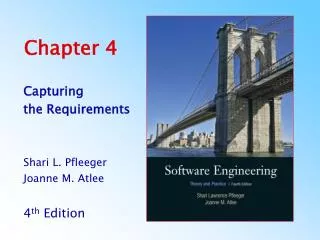
Chapter 4
Chapter 4. Capturing the Requirements Shari L. Pfleeger Joanne M. Atlee 4 th Edition. Contents. 4.1 The Requirements Process 4.2 Requirements Elicitation 4.4 Types of Requirements 4.4 Characteristic of Requirements 4.5 Modeling Notations
1.44k views • 101 slides
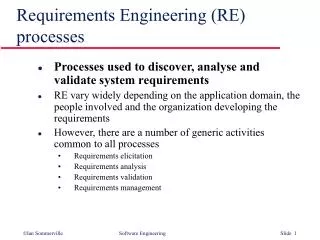
Requirements Engineering (RE) processes
Requirements Engineering (RE) processes. Processes used to discover, analyse and validate system requirements RE vary widely depending on the application domain, the people involved and the organization developing the requirements
596 views • 32 slides
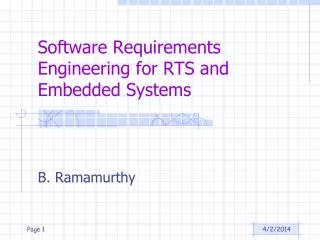
Software Requirements Engineering for RTS and Embedded Systems
Software Requirements Engineering for RTS and Embedded Systems. B. Ramamurthy. Topics. Requirements engineering process State machines Event-driven programming Table-driven methods. Requirements-Engineering Process.
349 views • 9 slides
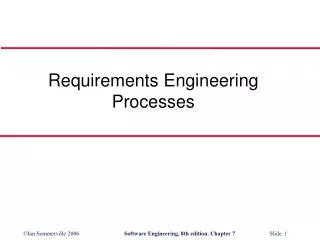
Requirements Engineering Processes
Requirements Engineering Processes. Objectives. To describe the principal requirements engineering activities and their relationships To introduce techniques for requirements elicitation and analysis To describe requirements validation and the role of requirements reviews
897 views • 52 slides

Requirements Engineering
Requirements Engineering. Definition: Description and Specifications of a system Topics covered: Functional and Non-functional requirement User Requirements System requirements The software requirements document. Software Requirements.
831 views • 26 slides
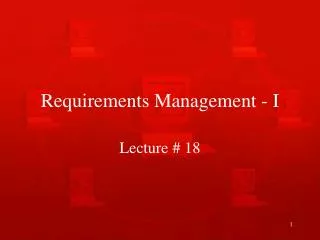
Requirements Management - I
Requirements Management - I. Lecture # 18. Requirements Engineering Process. Requirements Analysis and Negotiation. Requirements Elicitation. Requirements Specification. Requirements Validation. User Needs, Domain Information, Existing System Information, Regulations,
476 views • 32 slides

An introduction to requirements engineering
An introduction to requirements engineering. Objectives. To introduce the notion of system requirements and the requirements engineering process. To explain how requirements engineering fits into a broader system engineering process To explain the importance of the requirements document.
616 views • 29 slides
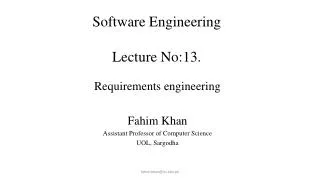
Software Engineering Lecture No:13. Lecture # 7
Software Engineering Lecture No:13. Lecture # 7. Requirements engineering Fahim Khan Assistant Professor of Computer Science UOL, Sargodha. Requirements Engineering. The broad spectrum of tasks and techniques that lead to an understanding of requirements is called requirements engineering.
487 views • 29 slides
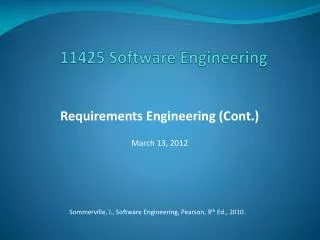
11425 Software Engineering
11425 Software Engineering. Requirements Engineering (Cont.) March 13, 2012. Sommerville , I., Software Engineering, Pearson, 9 th Ed., 2010. Overview. Requirements Specification Requirements and Design. Requirements specification.
318 views • 12 slides
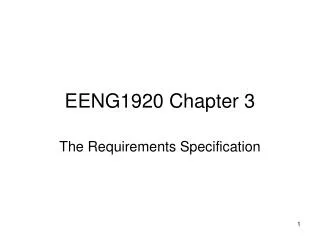
EENG1920 Chapter 3
EENG1920 Chapter 3. The Requirements Specification. Requirements Specification . Engineering Requirement Marketing Requirement Requirements Specification. Engineering & Performance Requirements. Engineering requirements
326 views • 23 slides
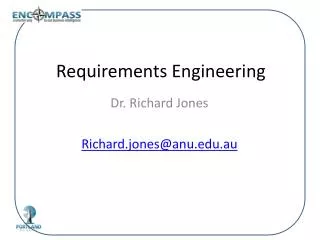
Requirements Engineering
Requirements Engineering. Dr. Richard Jones Richard.jones@anu.edu.au. Road Map. My background Definitions Why is requirement engineering important? Why is it difficult especially for s/w systems Keeping focussed Contract vs product development requirements Stories from trenches
790 views • 24 slides
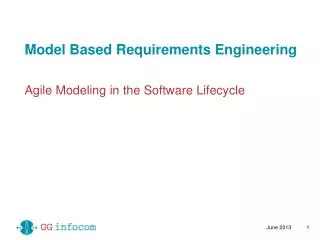
Model Based Requirements Engineering
Model Based Requirements Engineering. Agile Modeling in the Software Lifecycle. June 2013. 1. Model Based Requirements Engineering Content. A More Formal Approach to Structure Requirements Guiding Principles Part of Application Lifecycle Management (ALM )
606 views • 28 slides
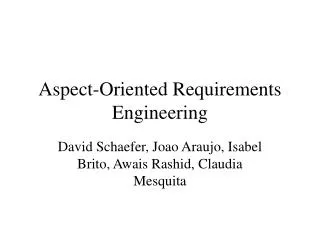
Aspect-Oriented Requirements Engineering
Aspect-Oriented Requirements Engineering. David Schaefer, Joao Araujo, Isabel Brito, Awais Rashid, Claudia Mesquita. Problems. How to identify aspects at the requirements level? What is the relationship between aspects and non-functional requirements, constraints and concerns?
253 views • 12 slides

Software Requirements and the Requirements Engineering Process
Software Requirements and the Requirements Engineering Process. Chapters 5 and 6. References. Software Engineering. Ian Sommerville. 6th edition. Pearson. Code Complete. Steve McConnell. (CC) The art of requirements triage. Alan M. Davis. Computer. IEEE. March 2003.
625 views • 25 slides
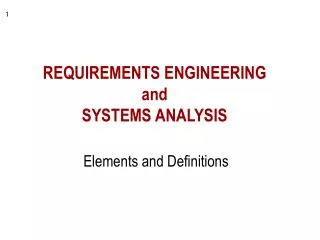
REQUIREMENTS ENGINEERING and SYSTEMS ANALYSIS
REQUIREMENTS ENGINEERING and SYSTEMS ANALYSIS. Elements and Definitions. Software Requirements Specification - SRS. Requirements. System Design. Detailed Design. Implementation. Installation & Testing. Maintenance. Who does requirements engineering?. customer. requirements engineer.
355 views • 16 slides
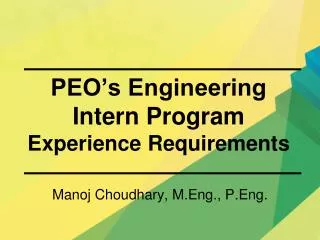
PEO’s Engineering Intern Program Experience Requirements
PEO’s Engineering Intern Program Experience Requirements. Manoj Choudhary, M.Eng., P.Eng. Objectives. Role of PEO Enforcement vs. Discipline Licensing Requirements CEAB Graduates International Engineering Graduates (IEG) Engineering Experience Benefits of Engineering Intern Program.
613 views • 33 slides

Requirements Elicitation
Requirements Elicitation. Lectures 10 & 11. References. Chapter 4: Requirements Elicitation from Object Oriented Software Engineering: Conquering Complex and Changing Systems. Introduction.
852 views • 51 slides

Chapter 3 Understanding Requirements
Chapter 3 Understanding Requirements. Requirements Vision Use-Case Modeling Software Requirements Specification Requirements Management Case Study and Project. Requirements. 3.1 Requirements. What is Requirements Types of Requirements Requirements Documents.
1.42k views • 97 slides

CSCI928 Software Engineering Requirements & Specifications Modeling System Interactions
CSCI928 Software Engineering Requirements & Specifications Modeling System Interactions. Tri A. Kurniawan, M.Eng. Ph.D Candidate tak976@uow.edu.au. Agenda. Introduction Early-phase of Requirements Engineering Late-phase of Requirements Engineering
411 views • 23 slides

CS 179 A Brief Review of Requirements Engineering Dr Eamonn Keogh
CS 179 A Brief Review of Requirements Engineering Dr Eamonn Keogh Computer Science & Engineering Department University of California - Riverside Riverside,CA 92521 eamonn@cs.ucr.edu. Requirements Engineering Definition : Establishing what the customer requires from a software system.
260 views • 14 slides

S WE 51 3 : Software Engineering
S WE 51 3 : Software Engineering. Requirements II. Details in Requirements. Requirements must be specific Examples -- university admissions system Requests for information received by email must be answered within one business day .
197 views • 8 slides

Requirements Engineering Processes
Requirements Engineering Processes. Objectives. To describe the principal requirements engineering activities and their relationships To introduce techniques for requirements elicitation and analysis To describe requirements validation and the role of requirements reviews
598 views • 52 slides
























